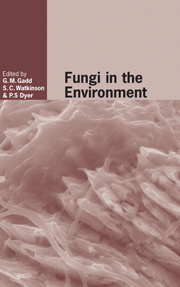Book contents
- Frontmatter
- Contents
- List of contributors
- Preface
- I Imaging and modelling of fungi in the environment
- 1 Imaging complex nutrient dynamics in mycelial networks
- 2 Natural history of the fungal hypha: how Woronin bodies support a multicellular lifestyle
- 3 Environmental sensing and the filamentous fungal lifestyle
- 4 Berkeley Award Lecture: Mathematical modelling of the form and function of fungal mycelia
- II Functional ecology of saprotrophic fungi
- III Mutualistic interactions in the environment
- IV Pathogenic interactions in the environment
- V Environmental population genetics of fungi
- VI Molecular ecology of fungi in the environment
- Index
- References
2 - Natural history of the fungal hypha: how Woronin bodies support a multicellular lifestyle
from I - Imaging and modelling of fungi in the environment
Published online by Cambridge University Press: 03 November 2009
- Frontmatter
- Contents
- List of contributors
- Preface
- I Imaging and modelling of fungi in the environment
- 1 Imaging complex nutrient dynamics in mycelial networks
- 2 Natural history of the fungal hypha: how Woronin bodies support a multicellular lifestyle
- 3 Environmental sensing and the filamentous fungal lifestyle
- 4 Berkeley Award Lecture: Mathematical modelling of the form and function of fungal mycelia
- II Functional ecology of saprotrophic fungi
- III Mutualistic interactions in the environment
- IV Pathogenic interactions in the environment
- V Environmental population genetics of fungi
- VI Molecular ecology of fungi in the environment
- Index
- References
Summary
Introduction
Fungal evolution and cell biology
Fungi are one of three major clades of eukaryotic life that independently evolved multicellular organization. They have radiated into a large variety of terrestrial and aquatic niches, employing strategies ranging from symbiotic to saprobic to pathogenic, and are remarkable for their developmental diversity and ecological ubiquity, with the number of species estimated to exceed one million (Hawksworth et al., 1995).
The fungi are highly varied in their mode of growth, ranging from unicellular yeasts to multicellular hyphal forms that produce complex fruiting bodies (Hawksworth et al., 1995). Hyphae grow through polarized tip-extension of a tubular cell (hypha), which can be partitioned by the formation of cross-walls called septa. Phylogenetic analysis reveals four major groups of fungi: the early-diverging Chytridiomycota and Zygomycota, and the Ascomycota and Basidiomycota (Fig. 2.1) (Berbee & Taylor, 2001; Lutzoni et al., 2004), which are sister clades that evolved more recently and contain the majority of fungal species (Bruns et al., 1992; Hawksworth et al., 1995). Hyphae are the predominant mode of vegetative cellular organization in the fungi and groups of fungi can be defined based on consistent differences in hyphal structure. The Zygomycota and Chytridiomycota can produce septa but these are infrequent in vegetative hyphae. In contrast, vegetative hyphae in the Ascomycota produce perforate septa at regular intervals and this is also found in the Basidiomycota, suggesting that this trait was present in their common ancestor (Fig. 2.1) (Berbee & Taylor, 2001).
- Type
- Chapter
- Information
- Fungi in the Environment , pp. 22 - 37Publisher: Cambridge University PressPrint publication year: 2007
References
- 1
- Cited by



